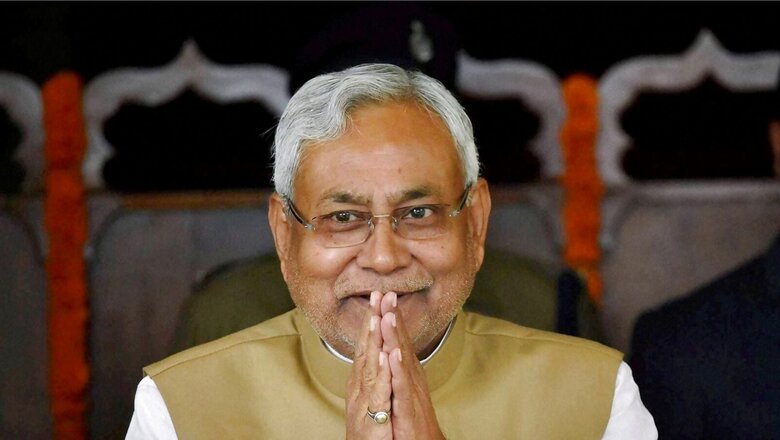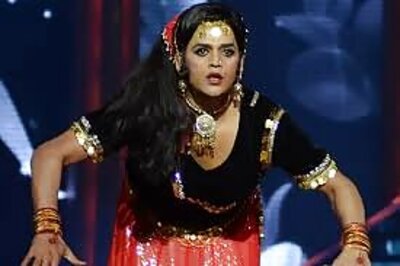
views
Apart from the possible “Shiv Sena fate”, another reason that pushed the Janata Dal (United) to leave the National Democratic Alliance (NDA) is the opportunity that Nitish Kumar may get to become the opposition’s prime ministerial candidate in the 2024 Lok Sabha elections. According to JD(U) leaders, now is the time to run for the PM post against Narendra Modi, as said by Upendra Kushwaha in a tweet. Kushwaha is the national parliamentary board president of the party.
But can Bihar chief minister Nitish Kumar, a master of U-turns who always seeks power but has seen a consistent political decline in his state, be considered PM material by the Bharatiya Janata Party’s rival camp?
Nitish had a good chance to pursue his PM aspirations between 2013 and 2017, but 2022 is going to be a different ball game for him, particularly after his latest U-turn.
How Nitish may have lost his chance
Nitish Kumar broke the alliance in June 2013 when the BJP made Gujarat chief minister Narendra Modi its prime-ministerial nominee. His party could win just two seats in the Lok Sabha election next year. In 2015, he allied with the Rashtriya Janata Dal (RJD) and Congress, his arch rivals, to begin a new political innings. Under his leadership, the Mahagathbandhan (MGB), a grand alliance of JD(U), RJD, and Congress saw a stunning victory in the 2015 Bihar assembly elections.
Therefore, Nitish had chances before him to enlarge his political canvas nationally. He was known as a leader who got mandate for good governance. Continuing in the CM chair since 2005, he was the senior-most politician in the rival camp of the BJP. Trinamool Congress’s Mamata Banerjee is the chief minister of West Bengal since 2011. Telangana Rashtra Samithi’s K Chandrashekar Rao is Telangana CM since 2014. Aam Aadmi Party convener Arvind Kejriwal is Delhi’s chief minister since 2015. Kejriwal was also Delhi’s CM between December 2013 and February 2014 for 49 days. He resigned citing resistance to the anti-graft bill Jan Lokpal and fought against Narendra Modi from Varanasi in the 2014 Lok Sabha elections.
Odisha’s Naveen Patnaik, CM since 2000, is the most senior of them all but he has never been vocal about his PM ambitions. Known for good governance and bringing development to Odisha, he has excelled in every assembly and Lok Sabha election since then, and he, in fact, has taken a pro-NDA stand on many occasions.
So, being the senior-most and getting mandate on governance, Nitish could outstrip all other regional political satraps as the opposition’s PM candidate, particularly after the Congress— the BJP’s main rival with a pan-India presence— was not in a position to claim the central position with its humiliating performance in the 2014 Lok Sabha elections where it could get just 44 seats and saw subsequent losses year after year in state assembly polls.
According to Brookings, a Washington-based think tank, Nitish was “certainly a political leader worth watching” after his “miracles” when “many had written-off Bihar as a failed state whose most prominent industry was kidnapping, and whose biggest export was people”.
Nitish lost that chance when he decided to ditch the MGB in 2017. His complaints were many, like the release of Mohammad Shahabuddin, once known as the “terror of Bihar”, and the investigation of graft cases against Lalu Prasad Yadav and his family. Shahabuddin was arrested in 2005 and Nitish Kumar, as Bihar’s CM, reopened cases against him. Shahabuddin, who died of Covid last year, was very close to Lalu and was a member of RJD’s national committee.
Nitish Kumar was always aware of this. In fact, he and his party called RJD’s rule of 15 years, from 1990 to 2005, “jungle raj”. While he was the NDA’s chief minister in Bihar, he used to allege that Lalu, and wife and CM Rabri Yadav, had ruined Bihar in 15 years.
So, his decision looked more like a political opportunity. He was always feeling uncomfortable in the United Progressive Alliance (UPA) where Rahul Gandhi had to push and convince Lalu Yadav to make Nitish the CM nominee in the 2015 assembly elections. After the polls, RJD emerged as the largest party in the MGB. It meant Lalu was in the driver’s seat. He was intent on projecting his son Tejashwi Yadav, who was Nitish’s deputy and was, therefore, heavily involved in the state’s administration. For Bihar, it seemed, Lalu was the actual chief minister and Nitish just circumstantial, as Shahabuddin had said after he was released from jail.
Nitish Kumar could not continue in such a coalition and decided to part ways. He chose to return to his former ally BJP, as there he still had the edge. JD(U) had got 18 seats more than the BJP’s 53 and Nitish expected to be in the driver’s seat in the coalition.
But while the rest of the term went without any problems, it was a loss, both for Nitish Kumar as well as BJP’s political opposition nationally. Nitish effectively lost the possibility of becoming PM material in future elections when he decided to go back to NDA. No other strong regional political satrap is expected to accept such a “U-turn master” in a leadership role, particularly when someone is witnessing a consistent political decline.
A political front cannot deliver in elections if it has no leader to campaign for. Being an NDA partner, there was no possibility of Nitish Kumar, and the rival camp could not agree on any other candidate.
The result: the opposition faced an even worse outcome in the 2019 Lok Sabha election. BJP’s seats increased from 282 in 2014 to 303 in the 543-member Lok Sabha. The NDA got 352 seats, 16 more than the 336 in 2014. Congress’s humiliation continued even in 2019 when it could bag just 52 seats.
In Bihar, Nitish, being part of the NDA, got good results, but it was more of a reflection of the Modi wave. The BJP-led alliance won 39 of the 40 Lok Sabha seats. The saffron party, not Nitish, was the driver here, winning 17 seats. The JD(U) got 16 seats and Lok Janshakti Party (LJP), another NDA party, won 6 seats.
Political dead end?
In the 2014 Lok Sabha elections, the JD(U) got just two seats against the BJP’s 31 out of a total of 40 in the state. Nitish’s electoral bad luck continued in next year’s assembly polls, though JD(U) performed better than the BJP. The largest party of the state was number two this time. JD(U) got 71 seats against its alliance partner RJD’s 80. That put Lalu in the driver’s seat in the alliance.
The 2019 Lok Sabha election was largely a Modi wave phenomenon in Bihar and India, and Nitish’s party, back in the NDA, performed well. But the 2020 assembly election results put an effective end to Nitish’s future national plans if it decided to join the opposition ranks, when the JD(U) was pushed to the third spot. BJP was now number two with just one seat less than RJD’s 75. JD(U) had managed 43 seats. It was also reflected in the vote share. JD(U) fought on 115 seats and got 15.39% of the votes in the 2020 assembly elections. BJP contested 110 seats and got 19.46% of the votes.
The JD(U) had the highest vote share in the 2010 assembly elections when it got 22.58% of the votes, against RJD’s 18.84% and BJP’s 16.49%. In the 2015 assembly polls, JD(U) was pushed to the third spot in vote share while the BJP got the highest share of votes, at 24.42%. RJD managed 18.35% and JD(U) 16.83%.
If we see the electoral data, Nitish looks like a spent political force now in Bihar. Therefore, there would be valid questions about his national ambitions in the future.
Times have changed
India has three strong regional satraps with PM aspirations. TMC leaders say Mamata Banerjee is most suited to become the PM candidate for the 2024 elections and have even launched a campaign for it. Mamata, unlike Nitish, has strong electoral achievements to back her claim. She has won all the assembly elections with a massive majority.
KCR has his own prime ministerial ambitions. Critical of PM Modi in recent days, he is preparing to come on the national stage since 2018. TRS leaders want to see KCR as the next prime minister. Like TMC, TRS has also won massive mandates in assembly elections, unlike Nitish Kumar.
Though Arvind Kejriwal in February 2022 said he was not in the race to become a PM candidate in 2024, the very next month, in March 2022, when exit polls announced AAP’s victory in Punjab assembly elections, party spokesperson Raghav Chadha said the Delhi CM was the hope of crores of people and, if people wanted, Kejriwal could be the next prime minister of the country. AAP is the only regional party now with governments in two states. Also, the party has won these elections with super mandates.
And above all, Nitish would also have to face the Congress’s ambitions of seeing Rahul Gandhi as the PM of India. Clearly, there will be few takers if Nitish Kumar’s name is proposed as the common candidate of the joint opposition in the 2024 Lok Sabha elections.
Read the Latest News and Breaking News here


















Comments
0 comment